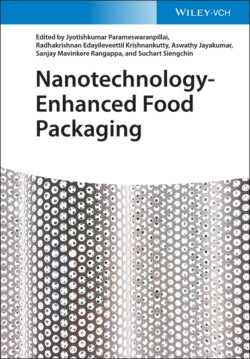Читать книгу Nanotechnology-Enhanced Food Packaging - Группа авторов - Страница 2
Table of Contents
Оглавление1 Cover
2 Title Page
3 Copyright
4 Preface
5 1 Introduction to Nanotechnology-Enhanced Food Packaging Industry 1.1 Introduction 1.2 Nanotechnology Applications in Food Processing 1.3 Nanotechnology Functions for Preserving or Shelf Life 1.4 Nanotechnology in Food Packaging 1.5 Nanocoating Applications in Food Industry 1.6 Nanocoats Used in Food Manufacturing 1.7 Importance of Nanolamine in Food Business 1.8 Antimicrobial Films Used in Food Industry 1.9 Nano-scavenging Oxygen Film Used in Food or Eating Substances 1.10 UV-Proof Processing of Foods Using Nanometal Oxides 1.11 Nano-intelligent Food Labeling 1.12 Nanotechnology-Aided Freshness and Spoilage Indicators 1.13 Nanotechnology-Aided Oxygen Indicators in Food Industry 1.14 Application of Nanotechnology in Product Identification and Anti-counterfeiting 1.15 Usages of Nanotechnology in Traceability and Active Tags in Food and Drug Industry 1.16 Conclusions References
6 2 An Overview of Biopolymers in Food Packaging Systems 2.1 Introduction 2.2 Main Polymers Isolated from Biomass 2.3 Main Polymers Obtained by Microbial Production 2.4 Main Biodegradable Polymers Chemically Synthesized 2.5 Conclusions Conflicts of Interest Acknowledgments References Note
7 3 Nanostructures Based on Starch, Their Preparation, Processing, and Application in Packaging 3.1 Introduction References
8 4 Cellulose Nanostructures and Its Application as Effective Food Packaging Systems 4.1 Introduction 4.2 Source of Cellulose 4.3 Cellulose Structure 4.4 Properties of Cellulose 4.5 Nanocellulose 4.6 Nanocellulose as Packaging Material 4.7 Comparison of Nanocellulose and Cellulose 4.8 Disadvantages of Using Nanocellulose in Food Packaging 4.9 Conclusions References
9 5 Chitosan-Based Nanoparticles and Their Applications in Food Industry 5.1 Introduction 5.2 Chitosan 5.3 Nanoforms of Chitosan 5.4 Chitosan-Based Nanoforms Applications in Food Industry 5.5 Updated Regulations in Application of Chitosan-Based Nanoparticles in Food References
10 6 Nutrients-Based Nanocarriers and Its Application in Packaging Systems 6.1 Lipid-Based Nanocarrier 6.2 Carbohydrate-Based Nanocarriers 6.3 Protein-Based Nanocarriers 6.4 Applications of Nanocarriers in Active and Bioactive Food Packaging 6.5 Outlooks and Perspectives References
11 7 Active Packaging Systems Based on Metal and Metal Oxide Nanoparticles 7.1 Introduction 7.2 Metal and Metal Oxide Nanoparticles Used in Active Food Packaging 7.3 Methods of Production of Metal and Metal Oxide Nanoparticles 7.4 Incorporation of Metal and Metal Oxide Nanoparticles into Food Packaging Materials 7.5 Effect of Metal and Metal Oxide Nanoparticles on Active Packaging Properties 7.6 Migration of Nanoparticles 7.7 Environmental Impact of Active Food Packaging Materials 7.8 Conclusions and Future Trends Acknowledgments References
12 8 Fabrication of Intelligent Packaging Systems Using Nano-Indicators and Sensors 8.1 Introduction of Intelligent Packaging 8.2 Nanoparticle-Based Temperature Indicators 8.3 Nanomaterial-Based Humidity Sensors 8.4 Nanomaterial-Based pH Indicators and Sensors 8.5 Nanoparticle-Based O2 Indicators 8.6 Nanomaterial-Based CO2 Sensors 8.7 Nanomaterial-Based Freshness Sensors 8.8 Conclusions and Perspectives References
13 9 Nanostructure-Based Edible Coatings as a Function of Food Preservation 9.1 Nanotechnology in Food Packaging: Principles and Applications 9.2 Edible Coatings 9.3 Safety of Nanocomposite for Application of Edible Coatings 9.4 Nanotechnology Regulation 9.5 Final Considerations and Outlook References
14 10 An Overview of Higher Barrier Packaging Using Nanoadditives 10.1 Introduction 10.2 Gas and Moisture Permeability Through Polymer Packaging Materials 10.3 Nanoadditives for Improving Barrier Properties 10.4 Methods to Prepare High Barrier Packaging Materials 10.5 Barrier Improvement by Reinforcement of Polymer Nanocomposites with Inorganic Nanoadditives 10.6 Barrier Improvement of Biopolymers by Reinforcement with Organic Nanoadditives 10.7 Conclusion References
15 11 Nanostructure-Based Multilayer Food Packaging Films 11.1 Introduction 11.2 Requirements of Food Packaging Systems 11.3 Multilayer Packaging Films 11.4 Structure and Functions of Multilayer Film Packaging 11.5 Nanotechnology-Based Multilayer Films 11.6 Preparation of Nano-Based Multilayer Films 11.7 Practical Applications of Multilayer Films/Coatings for Packaging of Food 11.8 Conclusion and Future Outlook References
16 12 Characterization Techniques for Nanostructures in Food Packaging 12.1 Introduction 12.2 Nanoparticles 12.3 Role of Nanoparticles in Packaging Applications 12.4 Nanocomposite in Food Packaging 12.5 Methods for the Development of Nanocomposites 12.6 Various Nanoparticles Employed in Packaging 12.7 Issues Associated with the Nanoparticle Incorporation 12.8 Characterization of Nanoparticles in the Packaging Materials 12.9 Conclusions References
17 13 Biodegradability Assessment of Biopolymer-Based Films 13.1 Introduction 13.2 Commercial and Renewable Biodegradable Polymers and Plasticizers 13.3 Biodegradation Mechanism 13.4 Biodegradation of Biopolymers with Additives 13.5 Considerations References
18 14 Nanobiotechnology in Food Preservation and Molecular Perspective 14.1 Introduction 14.2 Nanobiotechnology Aspects in Food Preservation and Food Packaging 14.3 Classification of Nanomaterials and Molecular Basis of Application 14.4 Nanomaterials and Active and Intelligent Food Packaging Applications 14.5 Nanomaterials and Postharvest Quality Parameters 14.6 Regulations and Safety Aspects 14.7 Conclusions and Outlook References
19 15 Environmental and Toxicological Aspects of Nanostructures in Food Packaging 15.1 Introduction 15.2 Nanoparticles in Food Packaging 15.3 Toxicity Measurement of Nanoparticles Used in Food Industry 15.4 Nanotoxicity 15.5 Migration Issues of Nanoparticles 15.6 Environmental Impacts of Nanoparticles 15.7 Conclusion Acknowledgments References
20 Index
21 End User License Agreement
